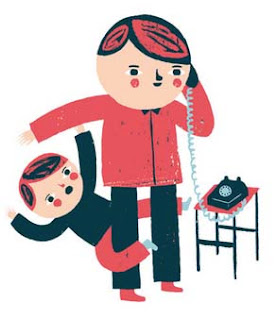

What can you do to help children learn to listen to a lesson without interrupting? How can you give a lesson without allowing children to continually blurt out comments and chat with each other? This is a question that is asked of me from time to time, and a scenario that my former student teachers and university field work students have often struggled with. Today I will give you suggestions and ideas to help you train your students to listen quietly through a lesson, which should to allow you to teach with a minimum amount of interruptions! Sometimes, getting your class to this point can be a lot of work, but it is certainly worth the effort.

Here is a recent question regarding classroom interruptions, etc., and the answer that I wrote for her.
I hope you will find it helpful!
“We’ve been loving using your materials since last school year. Maika is officially in Kindergarten this year and I still homeschool him. We are in a co-op once a week and I often have a hard time making the children (kindergarteners) focus in the classroom. Normally, a child is talking to another child when I am asking a specific question. Or a child thinks they know the material, but they have not necessary mastered the material, so he/she interrupts by saying “I already know that!” Or, “This is boring!” etc…. Any tips?”

This is my response:
1. Don’t Begin Your Lesson Until You Have Their Attention and They Are QUIET
Getting children to focus during a lesson is one thing, and getting them to stop talking is another. I usually will not begin a lesson unless I have everyone’s eyes on me, or nearly everyone’s eyes focused on me. Once I have their attention, THEN I begin my lesson. Don’t begin your lesson until you are confident that you are at least beginning with them focused on you. If you are asking for them to look at you and they are not, then start praising those that ARE ready and are focused by saying, “I like the way that Brian is sitting and looking right here,” etc. The more children that you name that are ready, the more likely it is that the others will snap to attention. If they don’t, then call their names and tell them that they need to sit down nicely and pay attention so that everyone can get started. That is what works for me.

2. Consistency is Your Best Friend
Now interrupting during a lesson is a separate issue and can be a very difficult thing to deal with for many teachers, especially new ones. Usually, I tell my student teachers that they must make an issue over the first and second interruptions, even if they are very small! If you let a even just a few of them go, then you will have many children shouting things out and talking during lessons. Once a few children had the satisfaction of telling you a “side story” in the middle of your lesson, and you have reinforced it by saying, “Wow!” or “That’s great,” then everyone else will want the same thing, and your lesson is effectively over.

3. Disrespectfulness is Unacceptable
Make sure that you nip any disrespectfulness in the bud as much as you can. If children are telling you that your lesson is boring, then they are being very disrespectful, and this is not acceptable! I would tell them that speaking to adults disrespectfully is not allowed, and then you must follow through with some kind of disciplinary action that you are comfortable with. That may be a time out, or a “thinking chair,” or whatever system you have in place. If you have no discipline plan in place, then that is your problem right there, I expect!
If the child said that he is bored and he was rude about it, then have that child move away from the group and write you a letter of apology or draw a picture of what they will do differently next time. If the child does not know how, then he or she will have to wait until the rest of the children are playing so that you will have time to help him or her with that assignment. If they don’t like this, then they will have to be more respectful and not tell you that they are bored in such a way next time. The child can be taught to raise his or her hand and tell you respectfully in a different way that they learned this once before. You can explain that though they may think that they have this mastered, they actually do NOT, and probably will benefit from the review.

4. Back Up and Try It Again
Here is another technique I use a LOT, especially at the beginning of the year. When the children start interrupting, I tell them that I am going to try that again, and they are going to be really quiet while I do that, or say that, or read that page again, or whatever it was we were doing. And THIS time, they are going to be quiet. If that doesn’t work, we back up and I try it AGAIN. I keep doing it again and again until the children are so annoyed with the ones that won’t stop talking that they start pressuring each other to be quiet. They don’t want to hear me re-read that page over and over again! And that’s what is going to happen if someone continually interrupts me!
5. Try the Interrupting Song
Another thing that helped me quite a bit last year, (though I haven’t started it yet this year,) is the “Interrupting Song” on the Classroom Management CD and DVD. Each time a child began to blurt something out, I just started quietly singing the words to the song:
Interrupting is very disrupting;
Don’t start squawking when someone else is talking!”
(And yes, those are all the words to the whole song! It just repeats itself a few times!) The rest of the class would begin to chant it along with me, and that pretty much took care of it! It was enough of a deterrent to make most of them stop, especially since the rest of the class joined in with me in it. It was like a joint effort to get everyone to quit interrupting! Here’s what the song looks like in the classroom, although when we did it “spontaneously,” we mostly did it without standing up, and without turning on any CD or DVD. Check out the video below:
Now I would say that my class last year had a pretty “thick skin,” in that I could be do things like this and nobody would start to cry, etc. I’m not positive that I would use the song in that way this year, because my students seem a bit sensitive this year. So I will just teach them the song, and may not begin chanting it with the kids when someone starts interrupting. It probably depends on the child, the situation, and the frequency of the interruptions, etc.

6. Remind the Children of the Rules Before You Start Your Lesson- (Especially the ones they have trouble with as a group.)
One thing that is very important to remember is that BEFORE you start any lesson, you must set your standards for behavior. Tell them before you start that the rules are that they must listen quietly while the teacher is talking, and that everyone else must listen quietly while their friends are talking. If your kids are already in the habit of breaking this rule, then you may have a difficult time breaking them of this bad habit and establishing a new routine.
Consistency is the key, so you must remember to stick to the same rule every single day, or you will never break them of the habit! So you will have to set your mind to the fact that this may be the case, and make your goal for the day (or for the next couple of days) simply be that the children listen to you nicely and quietly, without interrupting and without side conversations. You will probably need to have some kind of reinforcement system in place as well, such as a marble jar. Add a marble when you see that everyone is sitting nicely without rude comments, and praise the group for their good behavior. Perhaps the promise of a bit extra playtime or recess time would be a good incentive for them to work for?

7. Find Some Small Consequences that You Can Implement without Sending the Class into a Negative Downward Spiral
It is easier to be consistent with discipline when you are training your class to stop interrupting if you are not doing something like taking away a child’s ENTIRE recess, etc. So let the punishment fit “the crime!” Constant interrupting and chatting are small problems, not huge ones; so think about having the kids do things like help clean up the room for one minute during recess, and then two minutes, and then three, etc. The good thing is that little kids don’t really understand time very well, so they will still see it as a consequence when it’s happening. And then later they will still get the breaks that they need.
Retraining your class to stop chatting with each other and stop interrupting means that your students will need to readjust to “the new you.” So resign yourself to the fact that you may just have to discipline several of them at first, because children do often test the boundaries of their caregivers. In fact, some children need to find out each and every day where the limits have been set! So even though you KNOW you have told them dozens of times, get into the habit of always starting with the reminders of “… and we know of course that we are not going interrupt!” or something like that.
There have been many times when I have had to retrain my class, (like after they had a sub for several days,) so I told them that I was just going to have to be “Mrs. Meanie” for a few days until they remembered the rules a little bit better. And once everyone got back to their good little selves, they would get their nice teacher back. Other than that, Mrs. Meanie wasn’t going to give anyone any chances at ALL as far as interrupting or talking to friends during a lesson is concerned.
I think that this gave them fair warning! So when they started in being naughty, I just told them that I already explained that there were no chances for the next few days at all, and that I was really very sorry, but that they would just have to learn the hard way. After all, the easy way didn’t work; we tried it already, right?

8. Tell Them, “It’s My Job to Teach You to Listen without Interrupting.”
I often tell my class that it is my job to teach them to follow the rules in school, and if I don’t do a good job, the first grade teachers will be mad at me. So when they get to first grade and keep blurting things out without raising their hands, the first grade teachers will be upset with me and ask me why I didn’t do my job??? This helps me take the pressure off of myself when I have to discipline them; I just blame it on “those first grade teachers who will get mad at me,” or even the principal, who gave me the job of teaching them to listen quietly. I say that the principal will be mad at me if I don’t do my job.

9. Teach Your Students What Interrupting Is
You may also want to consider giving your students a lesson on what interrupting is, and why it is considered rude. Remember, some parents accept this type of behavior from their children (and teachers, too!) so children are not always aware that it is considered unacceptable by many. I really like the book Interrupting Chicken by David Ezra Stein for this purpose.

Another book that includes a section on interrupting is my own book, Wiggles Learns the Rules at School. I always teach the children all of the rules at school with this book using a little dog puppet to help me act out the story. It really captures their attention, and they LOVE it, every time! As a friend once said, “You know you are doing something right when the kids BEG you to review the rules!”

10. Give Children that Need It Some Interrupting “Tokens” for the Day
I don’t remember where I heard this suggestion, but it could work for a very impulsive child that is having a hard time controlling “blurting” out and interrupting. Give the child a certain amount (let’s say three or four) chips or tokens for the day to keep in a small container, such as an Altoids tin, etc. Or, perhaps the child could keep them on a necklace of some variety, and they could double as “fidgets.”
Each token represents one “chance” that the child may have for when he or she forgets to raise a hand and blurts something out. Have the child give you one of the tokens each time he forgets. When they are all gone, THEN you can implement your discipline plan. For some children, just giving up the token will be a bad consequence. If the child has all of the tokens at the end of the day, perhaps he could have a little extra time on an iPad, etc. The tokens serve as a visual and tactile reminder of how many (or how few) chances are left for the child.
I hope that these suggestions help you, and I hope that if your class is full of talkative little ones, that you are able to help them overcome it and move on from there!
I hope that these tips are helpful to you! If you have any questions that I might be able to help you with, just send them to info@heidisongs.com, or leave a comment below.
———————————-
Follow me! Did you enjoy this post? Do me a favor and share it with your friends! And follow this blog by signing up email updates, or follow on Bloglovin’, or follow me on TPT! I’m also on Pinterest, Facebook, Twitter, Instagram, Google+ and YouTube, too! Don’t forget to sign up for our email newsletter (on the left sidebar) for special deals and promo codes that you won’t find out about anywhere else.
















